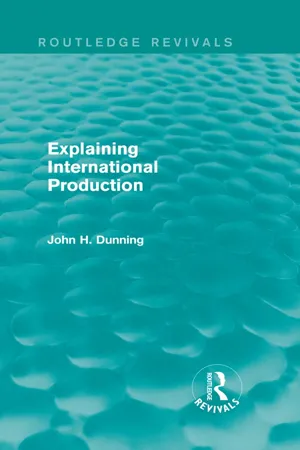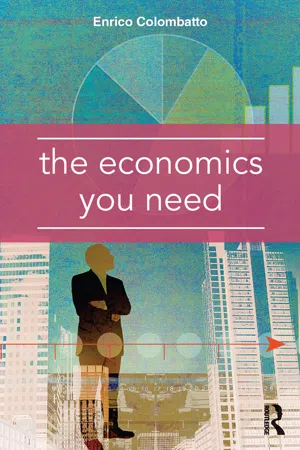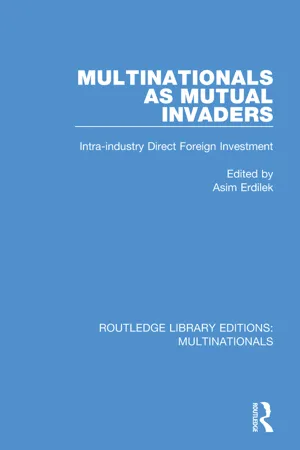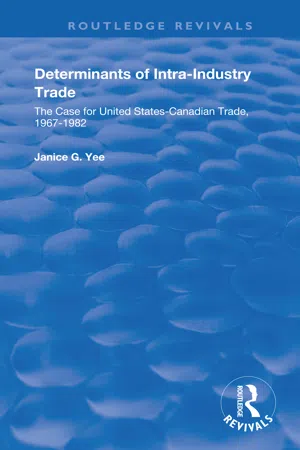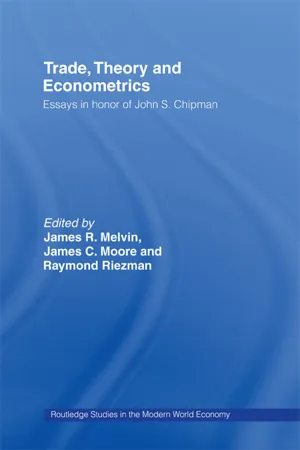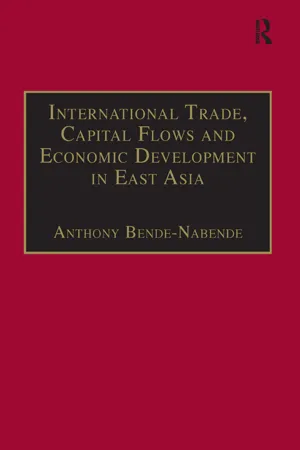Economics
Intra-Industry Trade
Intra-industry trade refers to the exchange of similar types of goods or services within the same industry between countries. This type of trade often occurs when countries have similar levels of development and produce similar products. Intra-industry trade allows for specialization and economies of scale, leading to increased efficiency and lower costs for consumers.
Written by Perlego with AI-assistance
Related key terms
Related key terms
1 of 4
Related key terms
1 of 3
8 Key excerpts on "Intra-Industry Trade"
- eBook - ePub
- W. Charles Sawyer, Richard L. Sprinkle(Authors)
- 2020(Publication Date)
- Routledge(Publisher)
CHAPTER 5Intra-Industry TradeMost students of international trade have long had at least a sneaking suspicion that conventional models of comparative advantage do not give an adequate account of world trade … [I]t is hard to reconcile what we see in the manufactures trade with the assumptions of standard trade theory.Paul KrugmanINTRODUCTIONI n our analysis of international trade you have learned why countries have a comparative advantage in producing different types of goods. The U.S. has a comparative advantage in machines and India in cloth because they are endowed with different factor proportions. However, a large share of international trade is not based on comparative advantage that results from different factor endowments. Countries also trade essentially the same goods with one another. This is known as Intra-Industry Trade. In this chapter, we will explain what Intra-Industry Trade is and how it differs from the interindustry trade that we have considered in the previous three chapters. As we will see, Intra-Industry Trade is determined by factors that differ from those involved in interindustry trade. As a result, a large part of this chapter is dedicated to explaining why Intra-Industry Trade occurs. Finally, we will examine the welfare effects of Intra-Industry Trade and show that it is as beneficial as interindustry trade.DEFINING Intra-Industry TradeUnfortunately, Intra-Industry Trade between countries coupled with the factor-proportions theory as the basis of trade poses a logical problem. The premise of the factor-proportions theory is that each country exports goods in which it has a comparative advantage. This comparative advantage reflects a country’s ability to produce the good at a lower opportunity cost. Countries have different opportunity costs because they have different resource endowments. As a result, the factor-proportions theory provides a basis for interindustry trade but not for Intra-Industry Trade. - John H. Dunning(Author)
- 2014(Publication Date)
- Routledge(Publisher)
O advantages of firms, which may strongly reflect their country of origin (Dunning, 1981, Chapter 4). Like specialization based on vertical trade in the spot market, such inter- Intra-Industry Trade flourishes in unrestricted markets; however, as consumer tastes may not be uniform across national boundaries, the characteristics of individual markets may play a more important role than in vertical trade.The second kind of horizontal inter-Intra-Industry Trade arises where the production of the goods in question requires different technologies and factors of production, but where the goods themselves are fairly close substitutes in consumption, e.g. leather and rubber footwear, nylon and cotton shirts, wooden and plastic chairs. As an explanation of this kind of trade, the disposition of factor endowments probably assumes a more important role; indeed, not only may goods be traded across countries, but between different firms in the same countries. Yet, sometimes there may be an element of complementarity in production, such as where a range of products requires similar distribution facilities. Therefore, O-specific advantages that relate to transaction-cost economizing might move in the opposite direction to L-specific advantages.Through contracts The motives for engaging in inter/intra-industry contractual transactions in goods and services are similar to those in the case of inter-industry transactions, but the nature of market imperfections may be different. While the desire to minimize the risks of supply instabilities may dominate contract inter-industry trade, quality control aspects are more likely to be important in its inter/intra equivalent. In this case, the O advantages enjoyed by the contractor are likely to be in the area of codifiable knowledge, while the contractee gains access to the markets of the contractor. In cases of shifting L- eBook - ePub
- Enrico Colombatto(Author)
- 2016(Publication Date)
- Routledge(Publisher)
This does not mean that unstable and highly regulated countries will be discarded altogether by entrepreneurs. Yet, these jurisdictions will often attract only highly lucrative business (to remunerate investors for the additional risks they run), and/or projects that do not require large investments, so that they can be managed by small firms, the size of which gives them the flexibility they need to deal with unreliable legislative contexts and heavy bureaucracies. Their trade patterns will thus show exports concentrated in high-yield, possibly capital-intensive industries that make limited use of skilled labour force.8.6 Intra-Industry Trade in manufactured goods
The previous section has discussed the pattern of specialisation in goods and services other than those involving significant quantities of natural resources. In particular, we have seen that bad institutions may affect the various industries to different degrees, and thus may generate a comparative-cost pattern, according to which countries that fare poorly in terms of institutions specialise in those industries that are less sensitive to the institutional context, while countries with good institutions specialise in the other sectors.This phenomenon helps us to understand inter-sectoral specialisation, according to which country A specialises in industry X and country B specialises in industry Y. What about Intra-Industry Trade, i.e. situations in which country A specialises in some market segments of both industry X and industry Y, while country B focuses on some other segments of the same industries?One may conjecture that different industry segments might have different institutional requirements, so that producers might make distinctions both across industries and within industries. A typical case is custom-made suits, which require highly skilled tailors working in small studios/workshops, as opposed to the production of clothes aiming at millions of potential consumers, a production that requires large capital investment and a much less skilled labour force. More generally, however, the explanation comes from the presence of economies of scale (see also section 8.1). In order to keep costs low, it is advisable not to produce small quantities of all the potential versions of a given product, but only a limited number of them. In other words, it is better to produce large quantities of single items, rather than small quantities of a broad range of articles. This might not apply to a large country like the USA or China, in which there are many producers who can cover the entire spectrum, but it is certainly relevant for smaller countries like the Netherlands or Slovenia, in which a relatively small number of companies can only cover a share of the industry. Thus, while the choice of segments can indeed be the result of the institutional context (see section 8.5), one should not underestimate the role played by happenstance and tradition, possibly driven or supported by the features of local demand (see section 8.4). - eBook - ePub
Multinationals as Mutual Invaders
Intra-industry Direct Foreign Investment
- Asim Erdilek(Author)
- 2019(Publication Date)
- Routledge(Publisher)
Such inter-intra-industry production is directly complementary to intra-firm trade and rests on the practicability of inter-country plant specialisation and the failure of external markets to organise transactions involving interdependent activities. It tends to be closely related to the extent of an enterprise's multinationality and to evolve out of the first two kinds of foreign production. Indeed, the growth of the common ownership of assets across national boundaries, by facilitating the rationalisation of the production, marketing and inventory control of similar products or processes-in different countries, may well have been one of the most important forces in the expansion of inter-Intra-Industry Trade. In the mid-1970s, intra-firm trade accounted for between 3 5 per cent and 40 per cent of all trade in industrial plants of OECD countries, outside Japan (Dunning, 1981a); and, the greater part of this was in sectors in which Intra-Industry Trade is above average (Helleiner and Lavergne, 1980).Intra-industry Transactions (Cells G, H and I)
Through Spot Markets (Cell G). At the opposite extreme to H-O-S type transactions are those in identical or almost identical goods, that is, which are substitutable both in production and in consumption. Theoretically, unless one assumes zero transfer-costs, there can be no such trade under conditions of atomistic competition. Allowing for differences in the production functions of firms, or for economies of scale, it is possible to conceive of one-way trade. But for two-way trade, one has to accept a different kind of country-specific O advantages, for example, those that relate to product quality, brand image, advertising, packaging, etc. and the willingness of firms to penetrate each other's markets, in spite of the additional transfer and other costs involved (Hirsch, 1976). This is most likely to be the case where the international market structure is oligopolistic, and constituent firms prefer to produce in each other's territories rather than adopt an alternative strategy.10Once one permits some degree of product differentiation, the possibilities for Intra-Industry Trade are enlarged. This suggests a desire for variety on the part of the consumer. It also suggests that the trademark-type O advantages of firms between countries give rise to products for which there is at least some demand in foreign markets. It is a typical monopolistic competition situation where a consumer in one country is willing to purchase not only domestic goods, but also product variants produced in other countries. Indeed, in smaller industrialised countries, export markets may dominate the pattern of product innovation. - eBook - ePub
Determinants of Intra-Industry Trade
The Case for United States-Canadian Trade, 1967-1982
- Janice G. Yee(Author)
- 2021(Publication Date)
- Routledge(Publisher)
III
The Evolution of Intra-Industry Trade
DOI: 10.4324/9781003249191-3Much like many theories, economic or otherwise, the theory of Intra-Industry Trade (IIT), i.e. the trade of substitutable goods across international borders, has been addressed for a time period which is greater than its present importance suggests. IIT gained some notice when it was mentioned in Taussig’s work on international trade (1927). Taussig briefly considered the occurrence of exchanges of similar exports and imports if countries’ demand preferences warranted such trade. At the time this concept was overshadowed by an international community which was preoccupied with the classical theory of trade and the problems of rationalizing the accompanying labor theory of value. However, Taussig’s remarks did not go unnoticed. After the advent of the Heckscher-Ohlin theory (H-O) and its ability to explain trade outside of the confines of the labor theory of value, empiricists wished to test the model against actual trade behavior. Thus began a long struggle between empiricists and theorists in attempting to determine the validity of the H-O model and its applicability to trade flows. The model, while correct given its assumptions, is not able to explain all types of trade. Its simplified explanation of tendencies does not readily cope with a far more complex set of causes and effects of trade. Much like the classical model was undermined by the labor theory of value, the H-O model’s strengths and real-world applicability depend heavily on the following assumptions: - eBook - ePub
- James R. Melvin, James C. Moore, Raymond G Riezman(Authors)
- 2012(Publication Date)
- Routledge(Publisher)
2 We may recall the questions raised by this procedure, unresolved to this date, when the Chamberlin-Robinson revolution broke out in the early 1930s, and particularly Robert Triffin’s (1940) argument that there was no persuasive way to break and segment the chain of commodities into industry groups and that it was best to abandon the concept of industry. Evidently, while theorists are aware of this problem, they have had to proceed as if there was a satisfactory definition of industry as an agglomerate of commodities that are close substitutes in consumption whereas outside-of-industry commodities are less close substitutes with the intraindustry commodities.3 This emphasis on localized technical change, based on local market conditions, as a source of advantage resonates in the current business school literature, as in Michael Porter’s (1990) The Competitive Advantage of Nations. Of course, his aim was to account for concentration of activity, but is easily adapted to account for several centers, each based on local characteristics, with intraindustry exchange.4 This finding of Finger’s raises serious difficulties also for the economists who have used the factor-intensity definition of intraindustry trade while also citing SITC data to argue that there is a great deal of intraindustry trade today.5 To our knowledge, however, any formal demonstration of a “larger” volume of trade between countries with dissimilar rather than similar endowments is not to be found in the literature for the simple reason that the theory of bilateral trade in a multi-country world is practically non-existent.6 - eBook - ePub
International Trade, Capital Flows and Economic Development in East Asia
The Challenge in the 21st Century
- Anthony Bende-Nabende(Author)
- 2017(Publication Date)
- Routledge(Publisher)
Although the literature suggests both positive and negative effects, overall, the role FDI is playing in developing countries’ international trade is paramount. Theoretical literature and empirical evidence also suggests a causal relationship between FDI and trade. The decision to locate any part of the value-added chain wherever it is best for a firm, be it transnational or national, to convert global inputs into outputs for global markets means that FDI and trade flows are determined simultaneously. This increasingly simultaneous determination of FDI and trade flows and the role of FDI and trade in the economic development process have profound policy implications. To begin with, for governments this means that, increasingly, they have to make sure that their policies towards FDI and trade are in harmony with each other if they wish to take advantage of the interrelationship. More specifically, governments not only need to make it attractive for foreign investors to come to their shores, but they also increasingly need to make it attractive for domestic investors to stay on-shore, if they wish to fuel economic growth. In addition they have to institute policies that propel the improvement and deepening of the capabilities of domestic enterprises and upgrading these activities over time; that enable the tapping into TNC networks as conduits for trade; that strengthen the backward and forward linkages between TNCs and local firms; and that attract FDI into export activities.FDI and Intra-Industry Trade
Most of the foregoing discussion is conducted at the macro-level. Once a move is made to consider the FDI-trade nexus at an industry level, of course, the relationship becomes much more complicated. This is because of associated or secondary effects operating through exports of intermediate products, machinery or services by parent firms or other firms in a home country to foreign affiliates, regardless of the sector. Alternatively, it can be through associated FDI that often follows when investment in a particular product (whether a good or service) has been made.Specifically, trade is either intra-industry or inter-industry. Intra-Industry Trade (IIT) is trade within a given industry, while inter-industry trade is trade between different industries. IIT exchange might occur via FDI, which is generally hypothesized to be positively associated with the level of IIT, as TNCs are often multi-product firms. One result of FDI is greater specialization in production by plants located in different countries, giving rise to more IIT, both horizontal and vertical.Vertical versus Horizontal Intra-Industry Trade and FDI
A good starting point in discussing the link between FDI and IIT is to identify what comprises IIT. IIT can be divided into horizontal and vertical - eBook - ePub
- F.V. Meyer(Author)
- 2017(Publication Date)
- Routledge(Publisher)
When the US made such ‘advance payment’ to other industrial countries in order to ensure their adhesion to GATT, her negotiators could only have expected to ‘buy’ more inter-trade. In effect, she got intra-trade as well. The intention was to gain easier access to foreign markets for her exports. These included products of her increasing returns industries. Such products had specific uses and short market lives relative to their R & D stage. They already satisfied two of the conditions for intra-trade. The third condition, specialisation within industries, was made possible on an international scale through tariff reductions on items within the same product range. This is, of course, rationalisation after the event. To repeat, intra-trade was not foreseen at the time when the first major tariff reductions were made.Intra-trade was an outcome of freer trade policy which underwrote the intention of the policy makers. It made trade-led growth possible and so furthered integration. International economic relations tend to be easier with trade-led growth than with production-led growth. In the former case, an increase in trade leads to a growth of domestic production. In the latter, growth depends on success in a scramble for factors. Almost inevitably this implies different attitudes towards other producers. Where growth is trade-led, you join your partners and respect their values, including their prices. Where growth is production-led, you try to beat your rivals and undercut their prices, which means that you interfere with their values. It need hardly be said that mutual respect of values eases commercial relations.The cause of the freer trade policy was a mixture of motives which included the desire to underwrite peace through commerce, free trade theory which indicated that this was a suitable means towards that end, and the wish to provide wider markets for increasing returns activities. Common to the motives was equality: equality of the right to live, equality of the right to work (without having the proceeds of one’s work taxed away in a discriminatory manner), and equality of the right to innovate (without obstruction through artificial narrowness of markets). If it was not possible to equate national and foreign rights, at least it was possible to put all foreign rights (or lack of rights) on an equal basis through most-favoured-nation treaties, and to narrow the difference between national and most-favoured-nation rights through scheduled concessions. The end was equality of rights, the means the freer trade policy, and the economic outcome intra-trade.
Index pages curate the most relevant extracts from our library of academic textbooks. They’ve been created using an in-house natural language model (NLM), each adding context and meaning to key research topics.
Explore more topic indexes
Explore more topic indexes
1 of 6
Explore more topic indexes
1 of 4

